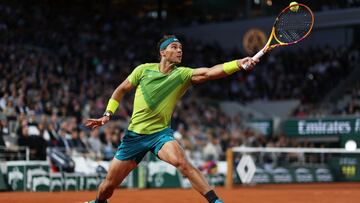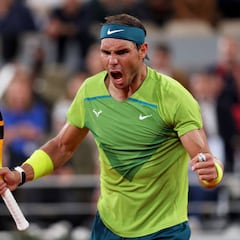Why is Rafa Nadal so good on clay?
Rafa Nadal has reached the final of Roland Garros again, his natural affinity for clay taking him to within a game of a 14th title in Paris.

Ever since Rafa Nadal won his first French Open in 2005 he has been the man to beat on clay, his favoured surface. Playing a five-set match against the Spaniard on clay is one of the most challenging prospects in the world of sport and his win-loss record is exceptional. The 13-times French Open champion, who faces Casper Ruud in Sunday’s final, is beyond doubt the greatest clay-court player of all time and his statistics on the surface will in all likelihood never be matched.
Nadal’s heavy topspin forehand – the most potent in the game - backed by his crushing, slightly flatter backhand, and his physical stamina make him particularly suited to clay. Additionally, left-handers are generally considered more difficult to read, which is why his former coach Toni Nadal decided early on to adjust Nadal’s forehand, initially a two-handed stroke like former Wimbledon champion Marion Bartoli, who hit two-handed off both flanks. Nadal is predominantly right-handed, but playing left combined with his natural athleticism allows him to get onto inside-out forehand cross-court bombs that rarely come back. As a natural right-hander, he also has greater control and precision on his two-handed backhand, which early in his career was more of a defensive shot, allowing him to hit winners from acute angles off both flanks. His topspin also produces a high bounce, which makes it difficult for opponents to generate power off it. Nadal is also a consummate rally builder, constructing the opportunity to hit winners with a flatter forehand after pounding his opposite number out of position.
See also:
Another key to Nadal’s success on clay is simply that he grew up playing on it in Manacor. Clay courts are predominant in Spain and Spanish players are more likely to learn their trade dreaming of winning Roland Garros than any of the other majors. There is a reason Latin American countries and Spain have produced so many great clay-courters: in Argentina, the percentage of clay courts is estimated to be 99%, in Chile, 96%, and in Spain, 84%. By contrast, in the UK just 1% of courts are clay, in the US 13% and in France, remarkably, just 15%. In Belgium, clay courts make up around 87% of all courts, which goes some way to explaining the successes of Justine Henin and Kim Clijsters on the surface.
Game face 🔛
— Roland-Garros (@rolandgarros) June 5, 2022
It's men's final day 🙌 #RolandGarros | @RafaelNadal pic.twitter.com/5WTGfUFkXM
Nadal an all-court player
But Nadal is not a clay-court specialist per se, despite being the greatest player ever to set foot on the red dirt. In 2002, he reached the semi-finals of the Wimbledon junior tournament and his returning ability has always given him an edge on any surface and his ability to put most of what comes at him back into court, coupled with a very consistent first serve, which he has been tweaking and improving since he started working with Carlos Moyá, makes him a formidable opponent. It is no accident that Novak Djokovic, who is also almost impossible to get past at the baseline, has beaten Nadal on clay more often than any other player, or that of the seven players to have beaten him more than once on the surface, three would be considered clay-court specialists: Fabio Fognini, Gastón Gaudio and David Ferrer.
Related stories
Much of what Nadal does better than anyone else on clay is in his mental fortitude. From a young age Toni Nadal drilled into his young charge the importance of not losing his cool, telling Nadal that if he smashed a racket then he would walk away. Over the course of his uncle’s tuition, Nadal learned not to get riled by his opponent, or the crowd, or by calls going against him. The power he holds over his emotions on court puts him at an advantage over his younger peers, some of whom are prone to meltdowns when the pressure is cranked up. The longer rallies on clay courts play into Nadal’s hands in that respect. He has also developed his game over the years, adding in the occasional serve-volley, coming into the net more, employing the backhand slice and working on other elements to back up the raw power that carried him to his early successes on clay.
MINDBLOWING 🤯
— Roland-Garros (@rolandgarros) June 3, 2022
and trailing set point!#RolandGarros | @RafaelNadal pic.twitter.com/rSFQ97j0As
Nadal: “The faster it is, the better”
As Roger Federer once noted, there is a common misconception about clay being a slow surface. According to the Swiss great, many clay courts today are faster than hard courts, and Nadal has taken full advantage of every weapon he has on the surface. “Some people get very confused about my game. They think it’s better if the court is slow, because I have a good defense. But the faster it is, the better for me. My spin is more painful for my opponents, my aggressive game works better.”


